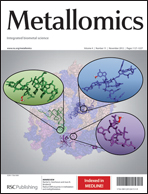The highly conserved human and mouse SLC39A14 and SLC39A8 genes encode the ZIP14 and ZIP8 transporters, respectively—functioning as divalent cation/bicarbonate symporters and expressed in dozens of tissues. Due to alternative splicing of exons 4, human and mouse SLC39A14 genes each encode two distinct gene products, whereas SLC39A8 produces a single product. This lab previously noted that ZIP14A and ZIP14B show highly variable expression in different cell types, suggesting differences in metal uptake function. We ligated mouse ZIP14A, ZIP14B and ZIP8 cDNA coding regions into the Xenopus-specific vector pXFRM, transcribed these in vitro, and microinjected the capped RNAs into Xenopus oocytes. Km and Vmax values for Cd, Zn and Fe uptake were determined. Electrogenicity studies using a potassium gradient confirmed that (just as we found previously for ZIP8) ZIP14A- and ZIP14B-mediated divalent Cd– or Zn–bicarbonate complexes are electroneutral. Competitive inhibition of Cd and Zn uptake with ten additional divalent cations showed a unique gradient of patterns for each of ZIP14A, ZIP14B and ZIP8. ZIP14 proteins are prominent in the gastrointestinal tract and ZIP8 protein is located on the surface of renal proximal tubular epithelial cells. It is known that renal Fanconi syndrome can be caused by five nonessential heavy metals: Cd2+, Hg2+, Pb2+, Pt2+ and U2+. In the present study we show that these five divalent cations are usually competitors of ZIP14- and/or ZIP8-mediated Zn uptake; our data thus support the possible involvement of intestinal ZIP14 for uptake of these five metals into the body and ZIP8 for efficient uptake into the kidney.

You have access to this article
 Please wait while we load your content...
Something went wrong. Try again?
Please wait while we load your content...
Something went wrong. Try again?


 Please wait while we load your content...
Please wait while we load your content...